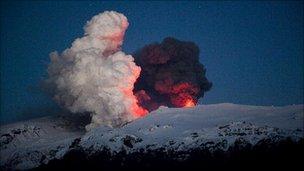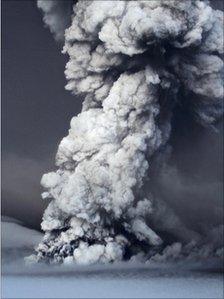Another giant UK ash cloud 'unlikely' in our lifetimes
- Published

The study has compiled a record of volcanic ash and debris that stretches back 7,000 years
The UK is unlikely to see another giant volcanic ash cloud in this lifetime, according to a new study.
The 2010 cloud cost European businesses more than £2bn and a smaller eruption this spring caused more anxiety.
But analysis of a record of such clouds stretching back into prehistory across northern Europe showed big ash clouds of the type seen in 2010 occurred on average only every 56 years.
The report has been published in the journal Geology, external.
While some ash clouds were witnessed and recorded by writers and artists through history, no such evidence exists from before AD1600.
Fortunately, a detailed 7,000 year record is preserved in peat bogs and lake beds in the form of microscopic layers of volcanic material, including ash, called tephra.
Now a team of scientists has compiled both the written history and sediment records from the UK, Ireland, Germany, Scandinavia and the Faroe Islands to show just how common these events are.
Over the last 1,000 years - when the best records are available - ash has fallen in northern Europe on average every 56 years. A computer model analysing the prevalence of ash deposits estimates a 16% chance of ash fall every decade.
Over the whole 7,000-year-period, they found 38 tephra layers in Scandinavia, 33 in Ireland, 14 in the UK and 11 in Germany.
'Pretty resilient'
This pattern of decreasing occurrence with more southerly latitudes can be explained when the source of the ash is considered.
"The vast majority are Icelandic," said co-author Gill Plunkett of Queen's University in Belfast.

The 2011 Grimsvotn eruption sparked fears of frequent ash disruptions
Chemical analysis showed that about a third comes from just one large Icelandic volcano, Hekla.
The prevailing westerly winds over the Atlantic are most likely to deliver ash to Scandinavia. However, when high pressure builds over Europe northerly winds are common over the Atlantic, bringing ash to Ireland and the UK.
Not all eruptions make far-travelling ash clouds; Icelandic eruptions have been far more common than ash deposits, averaging 20-25 per century for the last 1,000 years.
The authors caution that not all tephra are well preserved in peat - some may have dissolved in the acid conditions and disappeared from the record.
While Europe suffered economically from last year's eruption, past generations seem to have shrugged off the ash.
Looking back at the volcanic events recorded in Irish peat, Dr Plunkett sees little evidence of alarm.
"I'm sceptical that there was very much human impact - I looked to see if periods of volcanic activity correspond with cultural change in Ireland," Dr Plunkett told BBC News.
"We can look at particular eruptions and try to find out if there were changes in climate or changes in agricultural practices at the time, but I haven't found any correlation. I think we're pretty resilient," she said.
- Published23 May 2011
- Published24 May 2011
- Published25 April 2011